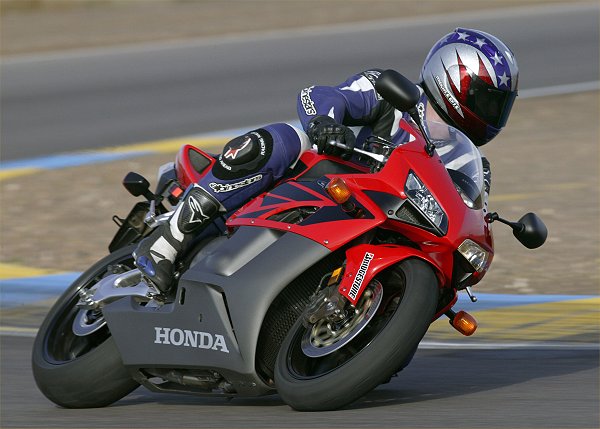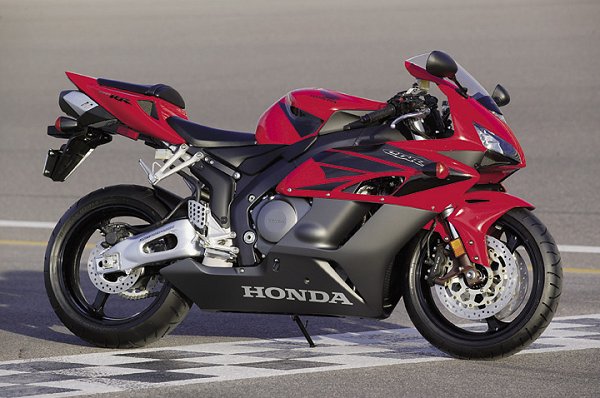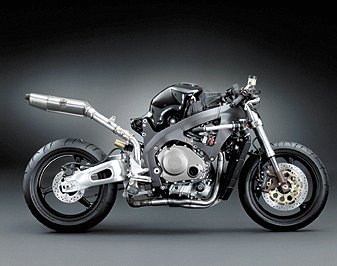
Every time you go to an important Honda press introduction, such as that held for the 2004 CBR1000RR in Phoenix last week, you get a good summary of relevant Honda history in the press kit. Frankly, it is part of the press kit I usually ignore . . . I want to get to the meat of the issue . . . the new bike, its technical features, specifications and development.
I intended to do the same thing this time, even though I had some history to offer MD readers from my own memory. The press kit just helped me brush up on that history.
Named “MD’s Motorcycle of the Century”, the 1969 CB750K is a bike whose significance I already understood quite well. The massive (for the day) in-line, four-cylinder powered machine really did send motorcycling in a new direction, in many respects. In terms of power, and even refinement, a new era was born.
The CBR750K shows Honda’s heritage with inline fours, but it isn’t the bike most relevant to this history discussion. That bike is the 1993 CBR900RR (which became known as the Fireblade throughout Europe). Like the CB750K, the 1993 CBR900RR marked an important point in motorcycle development history — specifically, with regard to open class sport bikes. In today’s world, it is almost inconceivable that a manufacturer could release an open-class sport bike eighty pounds lighter than its lightest rival in the class, but that is just what Honda did with the CBR900RR. It also featured radical steering geometry, and a lithe and nimble chassis, that left sport bike fans scratching their heads and drooling at the same time.
The 1993 CBR900RR also saw the emergence of a small, cigarette smoking Japanese engineer as a cult figure for motorcyclists intrigued by high performance. Tadao Baba was the LPL (Large Project Leader) for that model and the ensuing Fireblade offspring, straight through to the CBR954RR, which is the model replaced by the CBR1000RR.
There is irony in Baba’s legacy, however. While the 1993 CBR900RR broke the mold for the class with an extreme approach, the competition responded slowly but surely over the ensuing decade. The final iteration of the Fireblade developed by Baba for the 2002 model year (the 954RR) was an excellent motorcycle — significantly lighter and more powerful than the original 900RR, but it now resided in a class of even bigger performance bullies, including Yamaha’s R1 and Suzuki’s GSX-R1000.
While Baba emphasized light weight and high horsepower, as always, the 954RR was also intended to be a bike that appealed to a very wide audience of street bike riders. Baba was quoted in the 954RR press kit describing his goal as developing a bike with “an ever widening circle of appeal”. This contrasted somewhat with the “performance with no compromises” philosophy behind Yamaha’s R1, for instance. In effect, the extreme 1993 CBR900RR had evolved into one of the least extreme bikes in the class.
While Honda correctly noted that the reality in the open class sport bike field is an average customer whose sole use of the machine would be on surface streets, the harder-edged competitors, with their larger engine displacements, began to overshadow the latest Fireblade. Hard core performance creates media hype, and the R1 and GSX-R1000 were drawing sales from Honda’s 954RR.

With the 2004 CBR1000RR, Honda took a new direction. Knowing that this bike would be the platform for superbike racing, the “wide circle” was replaced by a more focused effort to maximize box-stock performance, and potential performance in “superbike trim”. While the design goal still included a balanced, rider-friendly performance, reflecting the fact that this is still a street legal machine intended for non-professional riders, everything possible was done to produce quick lap times on a race track, in that same package.

The 2004 CBR1000RR is not only the result of a new focus, it is an entirely new machine, physically. There is no hardware carried over from previous Honda motorcycles. It is new from the ground up.
The 998cc in-line four-cylinder engine is entirely new, as is the cassette-type six-speed gearbox and computer controlled ram air system.
Two fuel injectors per cylinder are also controlled by that sophisticated computer, sensing RPM and throttle opening. A single injector operates at lower rpm, while both injectors are activated further up the rev range. The throttle bodies are 44mm in size.


The underseat exhaust system contains some engineering tricks. A cable-actuated stainless steel butterfly valve sits downstream from the collector, and receives signals from the ECU. The valve helps tune exhaust pulses and back-pressure at specific engine speeds. Together with the computer-controlled fuel injection system and a two-stage ram air system, Honda claims the best of all worlds, including stupendous low-end torque, fat midrange, and a shrieking top-end.

While overkill for the street, perhaps, Honda built in advantages for racing, including that cassette gearbox mentioned above, a huge radiator (with 41.5% more cooling capacity than the prior model), and even a magnesium oil pan (375 grams lighter than a comparable aluminum pan) that resists structural deformation at extremely high temperatures (such as those reached during racing).
While the engine and gearbox are impressive, Honda may have saved its best engineering for the chassis of the CBR1000RR. Explaining the benefits of mass centralization in the press kit, Honda proceeds to describe the extreme efforts taken to centralize mass in the CBR1000RR.
Mass centralization begins with the engine design. While every high performance motorcycle seems to be headed towards shorter stroke and bigger bore dimensions, Honda went with a relatively long-stroke engine design, because the narrower bore allows the entire engine to be significantly narrower, and the chassis surrounding that engine to be narrower.
 |
|
Hoss (left) is bigger and faster than most,
but only bigger than Ben Bostrom (center) |
Likewise, the starter motor and drive gear were positioned on the right side of the engine, and the balancer shaft close to the engine’s center of gravity, all with an eye towards centralizing mass.
The Unit Pro-Link rear suspension system employed on Honda’s MotoGP race bike, as well as the 2003 CBR600RR (see discussion here) helps Honda centralize mass in several ways. The space freed-up by this unique rear suspension design allowed Honda to put the fuel in the CBR1000RR lower and in a more centralized position. Together with a rider position closer to the center of gravity, Honda claims to have successfully positioned two of the largest masses (fuel and rider) significantly closer to the roll axis of the bike.
Other components that are distant from the center of mass on the CBR1000RR were made as light as possible, including the headlights, LED tail lights, single-piston rear brake, and analog/digital electronic instrument panel.
Of course, many other components of the CBR1000RR are new, as well, including the frame and swingarm (now, the longest in the class), radial-mounted, four-piston front brake calipers (squeezing 310mm floating discs), and other features.

Honda claims this all adds up to the best sport bike it has ever produced, combining racing prowess with user-friendly, steetable performance.
With the class-leading GSX-R1000 as a benchmark, Honda pushed the CBR1000RR forward in terms of nimbleness and steering precision. A very important part of this bike’s overall performance package is the new steering damper. A departure from past Honda open-classers, the CBR1000RR incorporates a steering damper on the stock machine. Steering dampers are frequently a compromise in that they slow steering to reduce head shake and instability, but also make turn-in and direction changes a higher effort process. Honda wanted the best of both worlds, including a planted, stable machine that resisted head shake, while still being flickable and light feeling on the track and on the street.
The Honda electronic steering damper (HESD) employed on the CBR1000RR has no fixed damping characteristics. Instead, the damping force is computer controlled based on bike speed and acceleration. Oil traveling through a variable valve changes damping characteristics from virtually no damping to significant damping of the steering when needed. In theory, the best of both worlds, i.e., undamped steering for most circumstances and damped steering when necessary for stability.
Along with several other journalists, we had a chance to test the CBR1000RR on a race track in Phoenix, Arizona last week and, at this point, we are extremely impressed with Honda’s effort. Our test rider, Jeff “Hoss” Whitmer, is a big man with the skills to push a sport bike hard at the race track. Frankly, Jeff, who has owned and raced 600s, as well as open classers, was so excited about the CBR1000RR, I had to ask him to take a deep breath, and wait a few days to collect his thoughts. The funny thing is this, he did exactly what I said, but his words came out the same. Here is Jeff’s ride report.
This bike RIPS! I cannot believe that a bike with this much power handles as well as many of the 600’s I’ve ridden lately. The new CBR doesn’t do much wrong, it steers like a little bike and has the power of a locomotive.
The engine pulls from just above idle all the way to the rev limiter without a “hit” anywhere. The engine pulls harder with each rpm, but it is as “linear” as I have ever felt. You don’t realize how fast this bike is until you hit your brake marker a lot sooner than you expected. Then you quickly learn to appreciate the brakes because with one finger on the front brake lever the correct entry speed is just a light squeeze away. The brakes are as wonderful as the rest of the package, strong and usable.
After becoming a little more comfortable with the new track, I began trying to rattle the CBR’s composure, coming into slower corners a little slower and a gear lower, then hammering the throttle coming out. The CBR just hooks up and goes in the direction you have it pointed (I’m sure the all-new Bridgestone BT-014s these bikes are equipped with had a little to do with that, too). The CBR1000RR changes direction as easily as it launches you down straightaways. In fact, side-to-side transitions are so easy it’s almost shocking. The transmission is buttery smooth and after adjusting the shift lever to suit my taste, I never missed a shift.
I really enjoyed my time on the new CBR. It’s been a long time since I’ve been able to jump on a new bike and feel completely comfortable in just a few laps. I did on this bike. The one complaint I had is that the off/on throttle transitions are a little abrupt. The easiest solution I found to this problem was to run through corners a gear higher, and not completely close the throttle (not always easily done, but it made a huge difference for me).
Driving away from the track I couldn’t help but wonder, is this what Ben Bostrom was smiling about the whole time I saw him at the intro? I think so . . . and I think the results Honda had at the recent tire test at Daytona backs that theory. Honda did an excellent job on the CBR1000RR.
Take a look at Honda’s web site for all the details and specifications. Stay tuned for MD’s street test of the CBR1000RR.
homework help in
homework helper for kids
help to write a business plan
thesis online
i need math homework help
things to compare and contrast in an essay
macroeconomics homework help
writing essay services
online homework help sites
medical writing services
term paper writer help
help writing bio
resume creation service
dissertation help service
medical school essay help
help writing papers
help college algebra
custom thesis writing service
an indexer is not assigned to the shared services provider
customer service description for resume
writing homework help
help with maths homework
writing buy
coursework help gcse
customer service specialist resume
on line essays
reviews resume writing services
graduate school help
free homework help for kids
buy cheap essays
check writing service
essay introduction help
help writing fiction
book review services
sample research paper apa style
graduates schemes
importance community service essay
business blog writing service
critical essays on king lear
online resume writing
write essay for money
write essay outline
make a online resume
online resumes examples
precalculus homework help
personal statement writing service
help speech
buy a essay
tips on writing an essay
math help for homework
customer service experience resume
list of college essay topics
help with thesis writing
thesis online
essay online
homework help maths
online graduate classes
papers to buy
mba essay help
report writing help
essay writing online
help with my essay
critical analysis research paper
online writers
buying essay
online math homework help
help homework math
english coursework help
cheap custom research papers
write a college essay
free online essay writer
pay for homework
grade essays online
college essay service
resume service writing
speech scripts online
blog writing service
online book reports for kids
analysis paper format
online term papers
the diary of anne frank book report
research topics for college papers
essays free online
history thesis paper
homework help science
brainstorming essay writing
book summary service
buy cheap essay
need help with my homework
service custom essays
legit essay writing services
term paper help
buy persuasive essay
college custom
homework help math 7th grade
graduate internship jobs
write papers online
homework help tutor
copywriting services
helping kids with homework
online statistics homework help
communication thesis
help me with my essay





